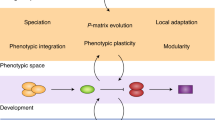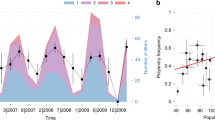Abstract
THE majority of the concepts of population genetics used in predicting possible progress in livestock breeding are derived from the known behaviour of single genes. An exception to this is the concept of the genetic correlation between two traits which is based on the statistical partitioning of their variances and covariance1. The genetic portion of these variances and covariance is then used to estimate a probable change in one trait when the second trait is selected for. Falconer2 has indicated the validity of this process for a particular case in that he obtained similar values for the genetic correlation between length of tail and body-weight in mice of six weeks of age from an experiment in which the response of each was measured when the other was selected for.
This is a preview of subscription content, access via your institution
Access options
Subscribe to this journal
Receive 51 print issues and online access
$199.00 per year
only $3.90 per issue
Buy this article
- Purchase on Springer Link
- Instant access to full article PDF
Prices may be subject to local taxes which are calculated during checkout
Similar content being viewed by others
References
Lerner, I. M., “Population Genetics and Animal Improvement” (Cambridge University Press, 1950).
Falconer, D. S., J. Heredity, 45, 42 (1954).
Mather, K., and Harrison, B. J., Heredity, 3, 1, 131 (1949).
Author information
Authors and Affiliations
Rights and permissions
About this article
Cite this article
COCKREM, F. Selection for Relationships Opposite to those predicted by the Genetic Correlation between Two Traits in the House Mouse (Mus musculus). Nature 183, 342–343 (1959). https://doi.org/10.1038/183342a0
Issue Date:
DOI: https://doi.org/10.1038/183342a0
This article is cited by
Comments
By submitting a comment you agree to abide by our Terms and Community Guidelines. If you find something abusive or that does not comply with our terms or guidelines please flag it as inappropriate.



